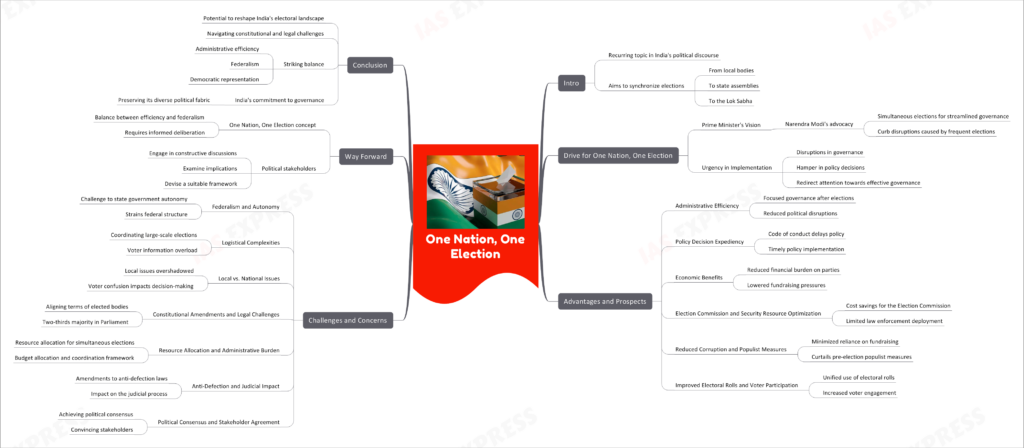One Nation, One Election- Prospects, Advantages & Challenges
The concept of “One Nation, One Election” has been a recurring topic in India’s political discourse. Proposed as a significant reform, it aims to synchronize various elections across the country, from local bodies to state assemblies and the Lok Sabha. While the idea is not new and has garnered both support and skepticism, it raises intricate questions about governance efficiency, legal implications, and the preservation of federalism.

This topic of “One Nation, One Election- Prospects, Advantages & Challenges” is important from the perspective of the UPSC IAS Examination, which falls under General Studies Portion.
The Drive for One Nation, One Election
Prime Minister’s Vision
- Prime Minister Narendra Modi has advocated for simultaneous elections to streamline governance and curb disruptions caused by frequent elections.
Urgency in Implementation
- Frequent elections disrupt governance and development efforts.
- Political focus on elections hampers policy decisions and project implementation.
- Concurrent elections can redirect attention towards effective governance post-elections.
Advantages and Prospects
Administrative Efficiency
- Focused attention on governance after elections conclude.
- Reduced political disruptions and paralysis of administration.
Policy Decision Expediency
- Elections lead to a code of conduct, delaying policy decisions.
- Synchronized elections facilitate timely policy implementation.
Economic Benefits
- Simultaneous elections reduce the financial burden on political parties.
- Election expenses are consolidated, lowering fundraising pressures.
Election Commission and Security Resource Optimization
- Reduced election frequency leads to cost savings for the Election Commission.
- Limited deployment of law enforcement personnel due to simultaneous elections.
Reduced Corruption and Populist Measures
- Single election cycle minimizes political parties’ reliance on frequent fundraising.
- Curtails governments from announcing populist measures before elections.
Improved Electoral Rolls and Voter Participation
- Streamlined process enables unified use of electoral rolls.
- Voter engagement can increase with reduced election frequency.
Challenges and Concerns
Federalism and Autonomy
- Simultaneous elections challenge state governments’ autonomy.
- Strains the federal structure by centralizing electoral cycles.
Logistical Complexities
- Coordinating large-scale elections across diverse regions.
- Voter information overload due to concurrent elections.
Local vs. National Issues
- Local issues might be overshadowed by national agendas.
- Voter confusion could impact decision-making during elections.
Constitutional Amendments and Legal Challenges
- Constitutional changes necessary to align terms of different elected bodies.
- Amendment process requires a two-thirds majority in Parliament.
Resource Allocation and Administrative Burden
- Massive allocation of resources required for simultaneous elections.
- Legal framework needed for budget allocation and coordination.
Anti-Defection and Judicial Impact
- Amendments to anti-defection laws may be necessary.
- Increased legal cases during elections might impact the judicial process.
Political Consensus and Stakeholder Agreement
- Achieving political consensus across parties, especially regional ones.
- Convincing stakeholders to support legal changes is a substantial challenge.
Way Forward
While the “One Nation, One Election” concept presents a promising avenue for streamlining governance and curbing political disruptions, it demands meticulous consideration. The balance between administrative efficiency, federalism preservation, and legal intricacies necessitates an informed and thorough deliberation. Political stakeholders must engage in constructive discussions, examining the implications from various angles, to devise a framework that suits India’s diverse democracy.
Conclusion
“One Nation, One Election” emerges as an idea with the potential to reshape India’s electoral landscape. However, its implementation rests on navigating through intricate constitutional amendments, legal adjustments, and securing political consensus. The reform’s ultimate success hinges on striking a delicate equilibrium between administrative efficiency, federalism, and democratic representation. As India contemplates the road ahead, the debate surrounding simultaneous elections underscores the nation’s commitment to effective governance while preserving the essence of its diverse political fabric.
Practice Question for Mains
Comment on the pros and cons of the ‘One Nation, One Election’. What is the way ahead? (250 words)

